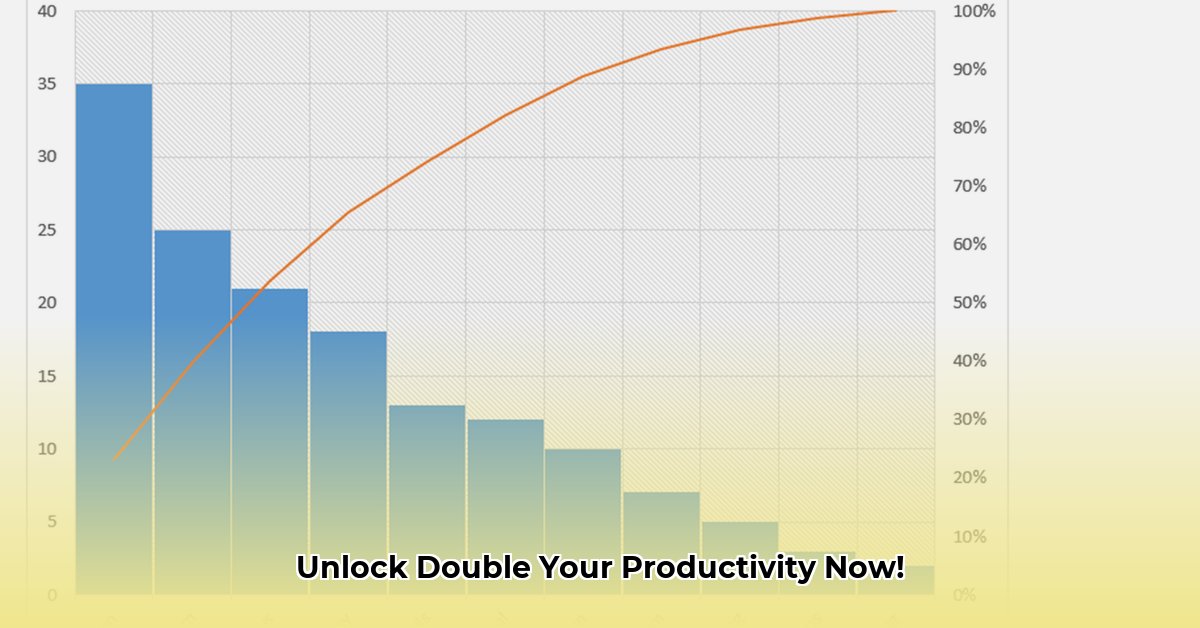Feeling overwhelmed and like you’re constantly busy without achieving significant results? You’re not alone. This guide reveals how to use the 80/20 rule – the Pareto Principle – to master your time and dramatically increase productivity. We’ll explore common pitfalls, provide actionable steps, share expert tips, and show you how to integrate this principle into your long-term strategy for success. Let’s take control of your time and achieve incredible results, leveraging the Pareto Principle for optimal time management.
Unlocking Productivity Secrets: Understanding the Core of the Pareto Principle
Life is a constant balancing act. Juggling work, family, and personal pursuits can lead to feeling overwhelmed. But what if you could dramatically increase your productivity with a simple yet powerful technique? The Pareto Principle emphasizes focusing your energy where it yields the greatest return, maximizing your effectiveness with the 80/20 rule.
Mastering Efficiency: Deciphering the 80/20 Rule for Enhanced Output
The Pareto Principle, also known as the 80/20 rule, highlights that approximately 80% of your results stem from only 20% of your efforts. How often do you dedicate hours to tasks with minimal impact, while a few key actions drive the majority of your success? This principle, observed across various domains from business to personal endeavors, emphasizes focusing on that crucial 20% for maximum impact, enabling strategic Pareto time allocation. Understanding this imbalance is the first step to reclaiming your time and boosting your output.
Identifying Key Activities: Pinpointing Your Crucial 20 Percent
How do you pinpoint this vital 20%? It requires honest self-assessment, meticulous tracking, and a clear understanding of your work habits and goals. It’s not just about working harder; it’s about working smarter.
Step 1: Time Tracking – Accurately Monitoring Your Daily Activities
Keep a detailed record of how you spend your time for about a week. Use a notebook, app like Toggl Track or RescueTime, or a simple spreadsheet. The key is granularity. Note every activity, even seemingly small ones, and the time spent on each. Be honest with yourself. This provides a realistic view of your current time allocation, revealing potential surprises about where your time is truly going, giving you insights for better Pareto efficiency analysis. Accurate tracking is the foundation for informed decision-making.
Step 2: Analyzing Results – Identifying High-Impact Activities
Analyze your data after a week to determine which tasks delivered the most significant results. Don’t just look at completed tasks; assess the impact of those tasks. Did they directly contribute to your key goals? Did they move the needle? These high-impact activities represent your 20%, potentially revealing surprising patterns in your productivity and guiding your focus toward more effective Pareto task management. Consider using a weighted scoring system to quantify the impact of different activities.
Step 3: Prioritizing Tasks – Eliminating Time-Consuming Activities
Now, focus your energy on your top three to five most impactful tasks. Delegate, automate, or eliminate less critical tasks that don’t provide a significant return. Saying “no” to non-essential activities is crucial for effective Pareto prioritization strategies. Be ruthless in your evaluation. Are you holding onto tasks out of habit or a sense of obligation? Freeing up your time from low-value activities is just as important as identifying your high-value ones.
From Theory to Practice: Implementing the Pareto Principle for Daily Success
Putting the Pareto Principle into practice requires a structured approach to integrate it into your daily routine. It’s not a one-time fix, but an ongoing process of refinement and adjustment.
1. Weekly Planning Sessions – Setting the Stage for a Productive Week:
Start each week by identifying your top three to five high-impact tasks. Writing them down makes them visible and serves as your weekly roadmap, ensuring focus on Pareto goals and objectives. Be specific and measurable in defining these tasks. What concrete outcome are you aiming to achieve?
2. Time Blocking – Scheduling Priority Tasks as Unmissable Appointments:
Schedule specific time blocks for these crucial tasks in your calendar, treating them as appointments you can’t miss to ensure dedicated time for what truly matters, reinforcing Pareto time commitment. Protect these time blocks fiercely. Communicate to others that you are unavailable during these periods, and resist the urge to multitask.
3. Minimizing Distractions – Creating a Focused Work Environment:
Eliminate distractions during your focused work periods by turning off notifications, silencing your phone, and closing unnecessary browser tabs. Consider using website blockers or noise-canceling headphones. Finding a quiet workspace can significantly improve concentration and uphold your dedication to Pareto focus techniques. The Pomodoro Technique (25 minutes of focused work followed by a 5-minute break) can also be helpful for maintaining concentration.
4. Regular Review and Adjustment – Continuously Refining Your Approach:
Reflect on your progress at the end of each week. Assess what worked well, what didn’t, and adjust your approach accordingly. This continuous refinement ensures ongoing improvement and adherence to the Pareto continuous improvement cycle. Track your progress and identify areas for optimization. The Pareto Principle is not a static formula; it’s a dynamic tool that should be adapted to your evolving needs and priorities.
Advanced Techniques: Maximizing Impact with Expert Strategies
The Pareto Principle extends beyond the basics. Supercharge your productivity with advanced strategies:
- The Eisenhower Matrix (Urgent/Important): Categorize tasks based on urgency and importance to focus on truly critical items, further refining your Pareto urgency prioritization. This matrix helps you distinguish between tasks that are important and urgent, important but not urgent, urgent but not important, and neither urgent nor important.
- Continuous Improvement – The Key to Sustained Productivity: Regularly review your approach, recognizing that your “20%” may evolve as priorities shift, supporting the Pareto adaption principle. Market trends, project requirements, and personal goals change over time, so your focus should also adapt.
- Task Batching – Combining Similar Tasks for Enhanced Focus: Group similar tasks to streamline your workflow and minimize context switching, saving time and mental energy with Pareto efficiency tactics. For example, respond to all emails at a designated time each day rather than checking them constantly.
Potential Challenges: Overcoming Common Hurdles in Implementation
Even with its effectiveness, challenges can arise when applying the Pareto Principle. Awareness of these obstacles and proactive strategies can help you maintain momentum.
| Challenge | Solution |
|---|---|
| Subjective Prioritization | Use data-driven methods like time tracking for objective task impact assessment. |
| Neglecting “Mid-Weight” Tasks | Schedule short, dedicated times to prevent these tasks from becoming overwhelming. |
| Difficulty in Complex Projects | Break projects into smaller tasks and apply the 80/20 rule to each for better focus. |
| Resistance to Saying “No” | Practice assertive communication skills and remember that saying “no” to low-value requests protects your time for high-value activities. |
| Perfectionism | Focus on progress, not perfection. Aim for “good enough” on less critical tasks. |
Mastering the Pareto Principle is a continuous journey of refining your approach to maximize time and achieve remarkable results. By consistently focusing on your high-impact 20%, you’ll unlock increased productivity and a sense of accomplishment.
Project Efficiency: Applying the Pareto Principle to Complex Projects Effectively
Key Takeaways:
- The 80/20 rule isn’t a rigid law but a guideline for prioritization. It’s a heuristic, not a hard and fast rule.
- Identifying the vital 20% requires careful analysis and may shift over time. What is most impactful today may not be most impactful tomorrow.
- Don’t neglect the remaining 80%; efficient management is crucial. These tasks still need to be handled effectively, even if they are not your primary focus.
- Successful implementation needs a balanced approach—focused effort and efficient task handling. It’s about creating a sustainable system that works for you.
- Applying the Pareto Principle improves productivity by focusing resources on high-impact tasks, supporting Pareto resource optimization. This frees up resources that can be used elsewhere.
Optimizing Project Tasks: Understanding the 80/20 Rule
The Pareto Principle highlights that 80% of your results come from 20% of your efforts. In project management, this means a small percentage of tasks often holds the key to project success. Correctly identifying that crucial 20% is vital for Pareto project success strategies. This requires a deep understanding of project goals, stakeholder expectations, and potential risks.
Methodical Breakdown: Identifying Your Vital 20 Percent in Projects
- Comprehensive Task Listing: List every task involved in your project, no matter how small. Use a work breakdown structure (WBS) to ensure all tasks are captured.
- Impact Assessment: Evaluate each task’s impact on project goals, assigning scores or using a numerical scale. Consider factors such as contribution to key deliverables, risk mitigation, and stakeholder satisfaction.
- Pareto Analysis: Categorize tasks based on impact scores to identify the “vital few.” A Pareto chart can visually represent this analysis, highlighting the tasks with the greatest impact.
- Prioritization and Resource Allocation: Focus your time and resources on the “vital few” tasks. Allocate your most skilled team members
- Doctor Work Life Balance: Proven Strategies for Physician Well-being - November 20, 2025
- Find Your Work-Life Harmony: Quotes for a Fulfilling Life - November 18, 2025
- CRNA Work-Life Balance: Strategies for a Healthier Lifestyle - November 16, 2025
















